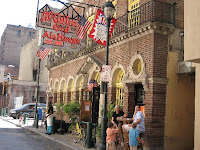In today’s tough times, advocacy is more important than ever. AIC continues to partner with organizations such as the American Association of Museums and National Humanities Alliance to advocate for funding and recognition for conservation and preservation in the U.S. However, we cannot do it without you.
How can you help AIC advocate on your behalf?
- Be part of our Emergency-Efforts Email Campaigns
- Sign up for our Advocacy List
- Engage in long-range advocacy efforts
AIC’s advocacy efforts have two tracks. One encompasses emergency efforts and other encompasses long-term efforts, and you can play an important role in both.
Emergency Efforts
These most often take the form of email blasts from AIC asking you to contact your members of Congress to encourage them to support or oppose a particular piece of legislation. AIC often gets very little notice in advance of legislation votes, so short emails sent to your members of Congress within 24 hours of receiving the AIC email are the most effective way to respond to these calls to action.
One important piece of information to remember is that members of Congress DO listen to their constituents, and these emails and phone calls do make a difference. However, timeliness is what is important, not a well crafted email or letter. Congressional staffers often just keep tallies of those calling or emailing in for or against a particular issue. The result of these tallies is often the only information passed on to the member of Congress.
So, when we ask you to take five minutes to cut and paste a message in an email and send it to your representatives, that is really all the time that is needed.
Some good examples of the important role individuals can play in the federal legislation process are the defeat of the two Coburn Amendments:
- Early this year Sen. Coburn attempted to prohibit museums from competing for or receiving any funds from H.R. 1, the economic stimulus bill. After a lobbying effort led by AAM in which AIC members were involved, the word “museum” was dropped from the final prohibition. Unfortunately, zoos and aquariums remained barred from competing for economic stimulus funding.
- More recently, on September 16, 2009, an amendment sponsored by Senators Coburn/McCain – which would have prohibited ANY funding from the Transportation Appropriations bill from going to ANY museum – was defeated on the Senate floor after another AAM lead lobbying effect.
Interestingly, a recent amendment that would have targeted museum funding proposed by Senator Coburn did not make it out of committee, which illustrates that building an effective lobbying effort can extend beyond a particular bill or amendment. I can envision a time when members of Congress will be fully aware that they don’t want to “rile” those conservation people.
Sign up for our Advocacy List
Join our advocacy-efforts list. AIC is developing a list of members who would like to be contracted beyond emergency efforts to assist AIC in broader advocacy work for the arts and humanities. You would be sent additional email blasts when action was needed on Federal issues and to keep you informed of actions being taken that might affect the arts and humanities. Also, we might be able to expand our efforts and advocate for state issues if needed
You can join the list today by:
- Login to the AIC website and click on Manage Your Profile and scroll down to Interests and select Advocacy Alerts
- Email resyler at conservation-us dot org and ask to be added to the list.
Long-Term Advocacy Efforts
These following organizations offer occasional training sessions on how to be a good advocate.
If we want conservation to have a greater focus in arts advocacy, we need to be represented. Take a few minutes to try to open up a dialog with the staff in your representative’s District Office. You can set up an appointment to talk about what you do, invite them on a lab tour, or include them in museum events.
We at AIC are happy to help you gather materials and make your case. Contact me at rseyler_at_conservation-us_dot_org.
Thank you!
Ruth Seyler





 Don’t just head home when the sessions end at 5:30 p.m. on Friday, June 3. Stop by Mcgilli
Don’t just head home when the sessions end at 5:30 p.m. on Friday, June 3. Stop by Mcgilli